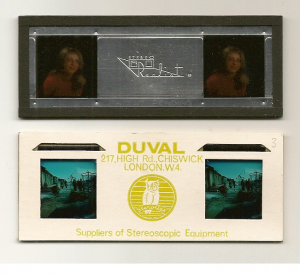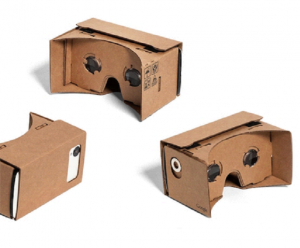Pat Heigham
An elderly aunt lent me a set of stereoscopic pictures, with the Victorian? stereoscope viewer.
They were of the First World War, and rather scary – German soldiers impaled upon bayonets, and the tanks moving over the trenches.
I used to mount the viewer in a cardboard box, and persuade my mother to insert a penny into a cut-out slot, whereupon I switched on a table lamp to illuminate the slide, and changed it manually.
Both a showman and entrepreneur at a very early age!
I got interested in stereoscopic photography and purchased a Viewmaster camera to make my own discs. The 35mm film was transported at a slight diagonal across the camera and with a special punch, the little pics were collected up and inserted into blank Viewmaster discs which had little slots around the circumference. Identification of L & R was with a slight notch built into the gate.
However, the small area of the format meant that the grain of the film was rather noticeable, so the next buy was a Stereograms Iloca which produced slides on 35mm film, same height but narrower width. These were chopped up and mounted in aluminium frames, then sandwiched in glass. There was a dealer in Chiswick which supplied all these things.
The picture below really just shows the mountings – the scanning lamp is not strong enough to render anything sensible with the actual photos (It’s not a dedicated slide scanner).
(Click on the picture below to see larger version:
use your Browser’s BACK button to return to this page)
I built a projector from a kit – twin lenses etc and with a silver screen surface and polarising filters/glasses could have 3D slide shows, but the strain on the eyes only lasted for about 50mins. Interestingly this is about the length of the IMAX 3D films, but that may have more to do with cramming in more audiences per day!
In those days I processed my own Ektachrome reversal at home and have some nice pics of the “Black & White Minstrels”, in beautiful colour and 3D.
On “Fiddler on the Roof”, the DoP let me have some short ends of the colour neg that was used (Eastman, I think) and my exposed film was tacked on to one of the rolls sent for processing at Technicolor labs, next to Heathrow), and I got back the positive print, separated out by the editors. This I discovered was fairly standard practice as DoPs often used a Leica or some such to check out lighting set ups or film stock exposures without running yards of 35mm film. (Doesn’t happen now with digital video! It has been said that a video cam is a most expensive exposure meter!)
I’ve seen 3D TV, and been impressed, but it’s necessary to choose whether you wish to look through a ‘window’ i.e. the image is beyond the screen, or have the image brought in front of you – much used by producers who want the ‘in yer face’ presentation. The 3D TV I saw at a colleague’s house was brilliant – it had both!
Bernie Newnham
My son has introduced me to Google Cardboard – https://vr.google.com/intl/en_uk/cardboard/. Just brilliant, I’ve ordered my own, after wandering Versailles, flying over Gibraltar, and lots more. You just need a smartphone.
(Click on the picture below to see larger version:
use your Browser’s BACK button to return to this page)
“Cardboard” has your phone in the slot instead of the slides. One of the demos puts you in the sky on Google Earth and as you turn round it’s as if you’re there – then you look down, about 10,000 feet to a village below.
Steve Jellyman
A good stereo app for your smartphone is ‘3dsteroidpro’.





